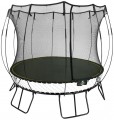Maximum weight
The greatest load that a trampoline is designed for, in other words, the total weight of people that it is able to transfer without consequences. This parameter is one of the main when choosing a trampoline. In no case should you exceed the maximum load, this is fraught with equipment breakdowns and serious injuries to athletes (moreover, such a nuisance can occur after exposure to an abnormal load, under a completely permissible weight). Accordingly, when choosing, it is worthwhile to clearly determine the maximum load that the product can be subjected to.
High maximum load values are especially important when installed in trampoline centers, gyms and other public places where the circle of potential athletes is unlimited, and among them there may be people of a very large build.
Test weight
The static test weight of a trampoline is the weight of the load that the product can safely support if this load is carefully, without shaking, placed on the canvas; in other words, the absolute maximum load allowed for this model.
The test weight is usually several times greater than the maximum load (see above). This is due to the fact that during jumps, the impact force is much higher than the weight of the person jumping directly: after all, a person falls onto the canvas from a height. It is believed that the test weight should be at least 4 times the maximum load — only in this case can we talk about the safe use of a trampoline. But the ratio can be even more impressive, and the higher it is, the more reliable and durable the design: for example, a trampoline with a test weight of 600 kg and a load capacity of 120 kg will be more durable than a model of 500 and 120 kg, respectively. So this indicator makes it possible to compare different models in terms of overall quality.
Trampoline size (LxWxH)
The overall size of the trampoline; in this case, the height can be measured both by the height of the working surface, without taking into account the protective grid and other additional devices, and by the overall dimensions of the product in the working position. Also note that the size of the working area on the canvas is usually less than the overall dimensions in length and width — there is protection along the edges that covers the springs, and it is undesirable to jump on it.
Number of springs
The number of springs provided in the design of the trampoline of the corresponding type (see above).
The smaller the springs, the larger and thicker each of them must be in order to normally carry their “portion” of the load. However manufacturers usually choose the thickness and quantity in such a way as to achieve the required performance. Therefore, from the user's point of view, there is no key difference between an abundance of small springs and a few large ones, and this parameter, in fact, is purely reference.

